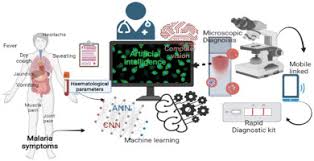Artificial Intelligence in Parasitology: A transformational shift
Dr. Bhavana Rathore1, Dr. Monika1
1Department of Veterinary Parasitology
PGIVER, Jaipur, Rajasthan University of Veterinary and Animal Sciences, Bikaner-334001, India
Parasitic diseases, continue to scourge animal and human populations worldwide, disproportionately affecting vulnerable populations particularly in resource-limited developing countries of global south. It has limited the use of conventional health-care delivery and disease control approaches and necessitated exploring innovative strategies.
A transformative shift in this direction, artificial intelligence (AI) is gaining substantial momentum in parasitic disease control, offering the potential for enhanced diagnostics, precision drug discovery, predictive modeling, and personalized treatment. AI, or Artificial Intelligence, refers to the simulation of human intelligence processes (such as learning, reasoning and decision making) by machines, especially computer systems.
Various AI tools viz. machine learning (ML), deep learning (DL), natural language processing (NLP) through the predictive AI algorithms can assisted in:
- AI-enabled accurate and rapid identification of parasites by analyzing microscopic images.
- Understanding parasite transmission patterns and outbreaks by analyzing vast amounts of epidemiological data, environmental factors, and population demographics.
- Drug discovery for parasitic diseases by identifying novel drug targets.
- Predicting the efficacy and safety of potential drug candidates.
AI has brought multiple benefits, from disease forecasting, drug discovery and development and diagnostics.
- By harnessing the power of AI and data analysis, predictive models have identified patterns and trends in disease incidence, enabling timely interventions to mitigate disease spread and protect public health. e.g. DeepMalaria, a Graph CNN-based DL process, was developed to find potential antimalarial compounds by Arshadi et al. (2020).
- AI-driven computational methods analyze vast amounts of data, including genomic, proteomic, and structural information, to unravel the complex mechanisms underlying parasitic diseases and identify potential therapeutic targets. This can lower the attrition rate and escalate the entire drug developmental pipeline from decades to months. e.g. DC-9237 was identified as the most promising drug candidate against malaria for its fast-acting nature by Novartis using a ML-based profile-quantitative structure-activity relationship (pQSAR) platform for screening potential drug candidates against malaria.
- AI is increasingly being used for drug repurposing that leverages existing drugs, already approved for other diseases, to tackle new medical challenges offers many benefits for patients, the health-care system, and the pharmaceutical industry. E.g. Williams et al. developed “Eve, which identified that the antimicrobial compound fumagillin has the potential to inhibit the growth of P. falciparum strains.
- AI, with its power of ML and DL algorithm, is revolutionizing parasitic diagnostics, offering faster, more accurate, and accessible solutions. These algorithms are trained on large datasets of parasite images, enabling them to identify specific morphological features and patterns with remarkable accuracy. E.g. ‘AIDMAN’, an AI-based system for malaria parasite detection in blood smears captured through smartphones, exemplifies the transformative potential of AI in parasitic diagnostics.
In conclusion, the present health-care landscape is burdened by several challenges, such as rising costs, limited access, clinician burnout, and inefficient resource allocation along with problem of timely detection and limited medical countermeasures adds to the burden during pathogen management. Fortunately, AI is emerging as a revolutionary tool across disease forecasting, drug discovery, diagnosis, treatment, and control.
References:
- Keshavarzi Arshadi, A., Salem, M., Collins, J., Yuan, J.S. and Chakrabarti, D., 2020. DeepMalaria: artificial intelligence driven discovery of potent antiplasmodials. Frontiers in pharmacology, 10, p.497924.
- Liu, R., Liu, T., Dan, T., Yang, S., Li, Y., Luo, B., Zhuang, Y., Fan, X., Zhang, X., Cai, H. and Teng, Y., 2023. AIDMAN: An AI-based object detection system for malaria diagnosis from smartphone thin-blood-smear images. Patterns, 4(9).
- Martin, E.J., Polyakov, V.R., Zhu, X.W., Tian, L., Mukherjee, P. and Liu, X., 2019. All-assay-Max2 pQSAR: activity predictions as accurate as four-concentration IC50s for 8558 Novartis assays. Journal of chemical information and modeling, 59(10), p.4450-4459.
- Parija, S.C. and Poddar, A., 2024. Artificial intelligence in parasitic disease control: A paradigm shift in health care. Tropical Parasitology, 14(1), p.2-7.
- Williams, K., Bilsland, E., Sparkes, A., Aubrey, W., Young, M., Soldatova, L.N., De Grave, K., Ramon, J., De Clare, M., Sirawaraporn, W. and Oliver, S.G., 2015. Cheaper faster drug development validated by the repositioning of drugs against neglected tropical diseases. Journal of the Royal society Interface, 12(104), p.20141289.


